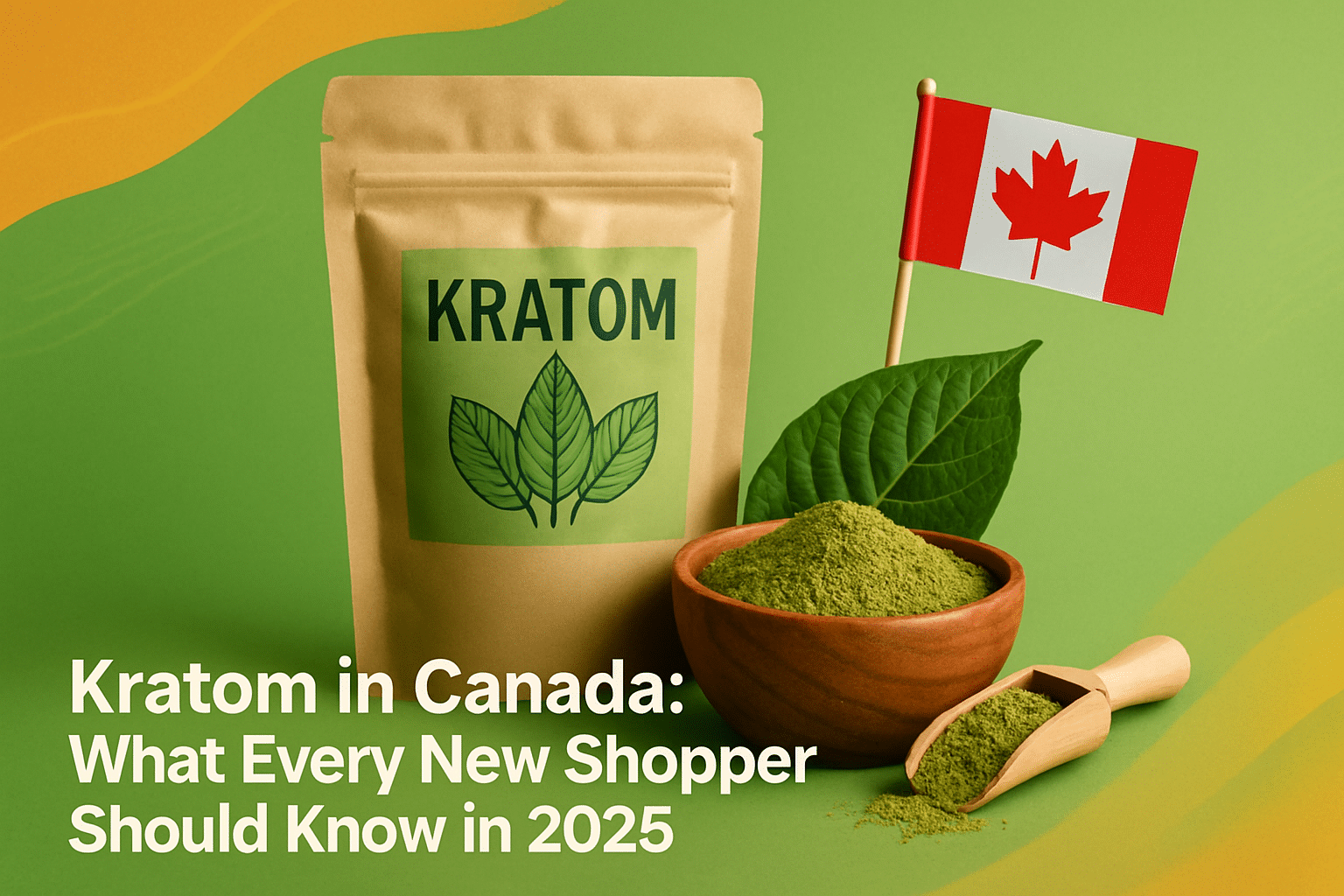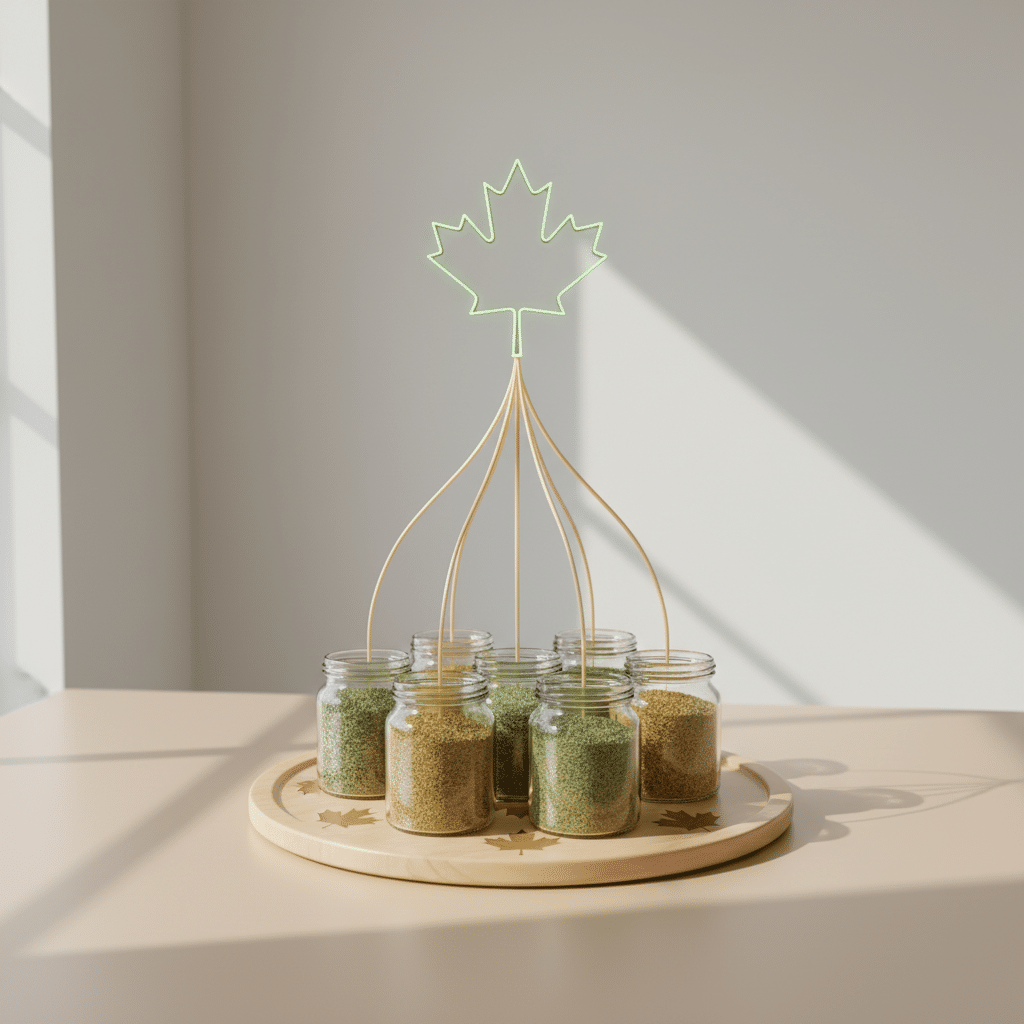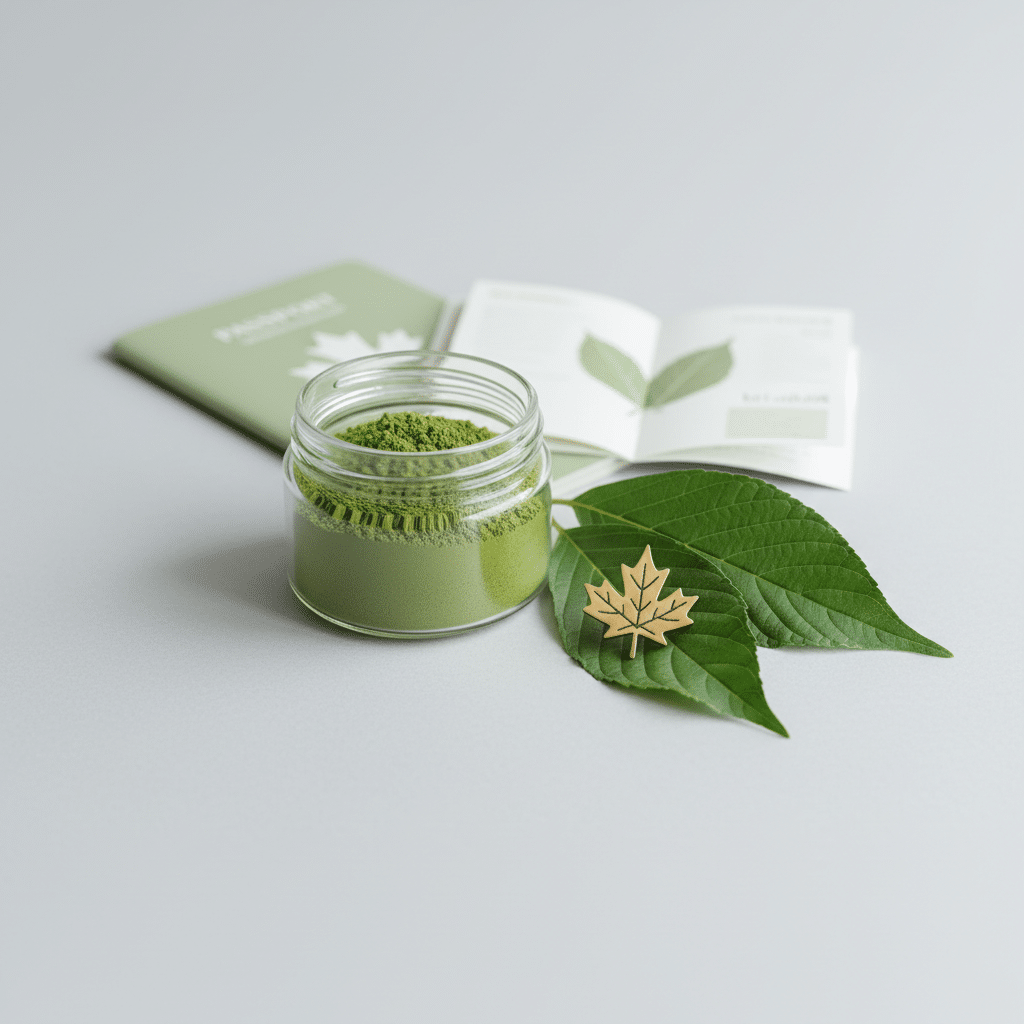
Navigating the kratom landscape in Canada requires careful attention to legal requirements, product quality, and vendor reputation. Recent surveys indicate that over 15 million Americans use kratom products, while Canadian usage continues growing despite complex regulatory frameworks. For new shoppers entering this market, understanding both legal boundaries and quality standards becomes essential for making informed purchasing decisions.
The Canadian kratom market operates within a unique regulatory environment where products remain available but heavily restricted in terms of marketing and health claims. New shoppers must navigate federal guidelines, provincial variations, and vendor compliance requirements to ensure safe and legal purchases. This comprehensive guide addresses the key considerations every Canadian kratom shopper should understand before making their first purchase in 2025.
Legal Status and Regulations for Kratom Shopping in Canada 2025
Current Canadian Federal and Provincial Kratom Laws
Kratom’s legal status in Canada remains complex but generally permissive for personal use. Kratom remains unregulated but permitted under certain conditions, with Health Canada prohibiting medical claims across all marketing materials. Federal regulations don’t classify kratom as a controlled substance, allowing its sale and possession throughout most Canadian provinces.
Provincial governments maintain authority to impose additional restrictions, though most align with federal guidelines. British Columbia, Ontario, and Quebec allow kratom sales with proper labeling requirements. Alberta and Manitoba follow similar frameworks, while smaller provinces generally defer to federal standards. Understanding how to buy kratom Canada 2025 requires checking both federal compliance and local provincial regulations.
The regulatory landscape continues evolving as health authorities monitor kratom use patterns and safety data. New shoppers should verify current provincial laws before purchasing, as regulations can change with minimal notice.
Health Canada Guidelines and Compliance Requirements
Health Canada maintains strict oversight of kratom marketing and labeling practices. Health Canada has recalled kratom products for quality violations, requiring vendors to avoid medical claims in all promotional materials. These guidelines prohibit vendors from advertising kratom for therapeutic purposes or making specific health benefit statements.
Compliance requirements include proper product labeling, accurate ingredient lists, and clear disclaimers about intended use. Vendors must avoid suggesting kratom treats, prevents, or cures any medical condition. Marketing materials can only describe kratom’s botanical properties and traditional uses in Southeast Asian cultures.
Quality control standards require vendors to maintain proper storage conditions, accurate potency testing, and contamination screening. Non-compliance results in product recalls, vendor penalties, and potential legal action. These requirements protect consumers while ensuring vendors operate within established legal frameworks.
Safe Purchase Practices Within Legal Framework
Smart kratom shopping requires understanding vendor compliance strategies and legal purchasing methods. Vendors often market kratom as “for research purposes” or non-edible forms to comply with CFIA regulations, allowing sales while avoiding therapeutic claims. This approach satisfies regulatory requirements while providing access to quality kratom products.
Legitimate vendors clearly state intended uses as botanical research, aromatic purposes, or educational examination. They avoid suggesting consumption methods or dosage recommendations. Product descriptions focus on strain origins, processing methods, and alkaloid profiles rather than potential effects or benefits.
Safe purchasing involves verifying vendor licensing, checking product labeling compliance, and confirming lab testing availability. Reputable vendors provide detailed certificates of analysis, maintain transparent business practices, and offer clear return policies. Budget kratom shopping Canada requires balancing cost considerations with quality assurance and legal compliance.
Essential Kratom Strains and Products Available to Canadian Shoppers
Red, Green, and White Vein Kratom Varieties
Understanding strain differences helps new shoppers select appropriate products for their research interests. Green vein varieties are frequently recommended for beginners due to balanced effects, offering moderate characteristics between red and white vein alternatives. Green strains typically provide steady alkaloid profiles suitable for various research applications.
Red vein kratom originates from mature leaves harvested during later growth stages. These strains generally contain higher 7-hydroxymitragynine concentrations, making them popular for evening research sessions. Popular red varieties include Red Bali, Red Maeng Da, and Red Thai, each offering distinct alkaloid compositions.
White vein kratom comes from younger leaves processed through specific drying methods. These strains typically contain elevated mitragynine levels and are often chosen for daytime research purposes. White Maeng Da, White Borneo, and White Horn represent common white vein options available to Canadian shoppers.
Popular Kratom Product Forms and Formats
Canadian vendors offer kratom in multiple formats to accommodate different research preferences and storage requirements. Powder remains the most common form, providing versatility for various applications while maintaining cost effectiveness. Fine-ground powders offer consistent particle sizes and rapid dissolution properties.
Capsule formats provide precise standardized amounts and convenient storage options. Pre-measured capsules eliminate weighing requirements while ensuring consistent research quantities. However, capsules typically cost more per gram than equivalent powder amounts and may contain fewer alkaloids due to gelatin capsule space limitations.
Extract concentrations offer higher alkaloid densities through specialized processing techniques. These products require careful handling due to increased potency levels. Liquid extracts, standardized extracts, and enhanced powders represent common concentrate options, though new shoppers should approach these with additional caution.
|
Product Format |
Advantages |
Considerations |
|---|---|---|
|
Powder |
Cost-effective, versatile |
Requires measuring |
|
Capsules |
Pre-measured, convenient |
Higher cost per gram |
|
Extracts |
Higher potency |
Requires experience |
Regional Origins and Their Characteristics
Indonesian kratom represents the largest supplier category for Canadian markets, with strains like Bali, Borneo, and Sumatra offering distinct alkaloid profiles. Indonesian processing methods vary by region, creating diverse product characteristics even within similar strain names. Bali kratom typically provides consistent quality, while Borneo varieties offer unique alkaloid combinations.
Thai kratom strains feature traditional genetics and time-tested processing methods, though export restrictions limit availability. Maeng Da varieties often originate from Thailand, representing carefully selected genetics with enhanced alkaloid content. These strains command premium prices due to limited availability and quality reputation.
Malaysian kratom provides alternative options with distinct growing conditions and processing techniques. Malaysian strains often feature unique alkaloid ratios due to specific soil conditions and climate factors. Green Malaysian and Red Malaysian represent popular options for Canadian researchers seeking variety in their botanical studies.
Quality Standards Every Canadian Kratom Shopper Must Know
Importance of Third-Party Lab Testing and Certificates
Laboratory testing provides essential quality assurance for kratom products sold in Canadian markets. Reputable vendors provide lab reports verifying contaminant-free status, crucial for quality assurance and consumer safety. These reports screen for heavy metals, pesticides, bacteria, and other potential contaminants that could compromise product safety.
Third-party testing ensures unbiased results through independent laboratory analysis. Vendors using in-house testing may face conflicts of interest, while independent labs provide objective quality assessments. Certificates of Analysis (COAs) should include testing dates, methodology details, and clear pass/fail results for all screened contaminants.
Lab tested kratom Canada requirements include screening for E. coli, Salmonella, heavy metals like lead and mercury, and pesticide residues. Additional testing may cover alkaloid content verification, moisture levels, and foreign matter detection. These comprehensive tests ensure products meet safety standards for research applications.
Recognizing Authentic Lab Reports and Certifications
Authentic lab reports contain specific technical details that distinguish them from fraudulent documents. Legitimate COAs include laboratory contact information, testing methodology descriptions, and certified technician signatures. They also feature batch-specific results rather than generic template data.
Key elements of authentic reports include accreditation logos from recognized testing authorities, detailed detection limits for each tested parameter, and clear sample identification linking products to specific batches. Reports should match vendor batch numbers and include recent testing dates reflecting current inventory.
Fraudulent reports often contain vague language, missing technical details, or unrealistic perfect results across all parameters. Legitimate testing occasionally identifies minor issues or trace contaminants within acceptable limits. Perfect scores across all categories may indicate fabricated results rather than authentic laboratory analysis.
Understanding Alkaloid Content and Potency Measurements
Alkaloid analysis provides insights into kratom potency and expected characteristics for research purposes. Mitragynine typically represents the primary alkaloid, comprising 60-70% of total alkaloid content in most strains. 7-hydroxymitragynine constitutes a smaller percentage but contributes significantly to overall potency profiles.
Quality vendors provide alkaloid breakdowns showing mitragynine percentages, 7-hydroxymitragynine levels, and total alkaloid content. These measurements help researchers select appropriate strains for specific applications. Higher total alkaloid content doesn’t always indicate superior quality, as alkaloid balance affects overall characteristics.
Seasonal variations, harvesting methods, and processing techniques influence alkaloid content in natural kratom products. Reputable vendors account for these variations through batch-specific testing rather than relying on historical data. Premium kratom shipping Canada typically includes batch information allowing customers to verify alkaloid content for their specific purchase.
Finding Trusted Kratom Vendors in Canada for New Buyers
Red Flags to Avoid When Choosing Kratom Suppliers
Identifying unreliable vendors protects new shoppers from quality issues and potential legal complications. Vendors making unverified medical claims should be avoided per Health Canada regulations, as legitimate suppliers focus on botanical properties rather than therapeutic benefits. These claims violate federal guidelines and indicate poor compliance practices.
Other warning signs include missing contact information, no return policies, and absence of lab testing documentation. Vendors refusing to provide Certificates of Analysis likely lack quality control measures. Extremely low prices often indicate inferior products, contaminated materials, or fraudulent operations.
Poor website security, missing business registration information, and unprofessional customer service suggest unreliable operations. Legitimate vendors maintain professional standards, clear communication channels, and transparent business practices. New shoppers should verify vendor credentials before making purchases.
Questions to Ask Potential Kratom Suppliers
Experienced kratom shopping requires asking specific questions about quality assurance and business practices. Inquire about testing frequency, laboratory partnerships, and batch tracking systems. Reliable vendors provide detailed answers and welcome quality-focused questions from concerned customers.
Ask about sourcing practices, including supplier relationships, harvesting methods, and import procedures. Best kratom vendors Canada maintain direct relationships with Indonesian farmers and processing facilities. They should explain their supply chain and quality control measures throughout the import process.
Request information about storage conditions, inventory turnover, and freshness guarantees. Kratom quality degrades over time, so vendors should maintain proper storage and regular inventory rotation. Fresh products provide better alkaloid content and overall research value.
Building Relationships with Reliable Canadian Kratom Retailers
Long-term vendor relationships benefit both shoppers and suppliers through improved service and consistent quality. Reliable retailers remember customer preferences, provide personalized recommendations, and offer early access to new products. These relationships develop through consistent purchases and professional interactions.
Established vendors like 365 Kratom Canada focus on building trusted communities through education, transparency, and exceptional customer support. Their comprehensive testing protocols and quality assurance measures create confidence for new shoppers entering the kratom market. Every batch undergoes thorough testing for purity and potency.
Communication remains essential for successful vendor relationships. Provide feedback about products, report any quality concerns, and ask questions about new strains or processing methods. Responsive vendors use customer input to improve their offerings and maintain high standards.
Practical Shopping Tips for New Canadian Kratom Buyers
Starting Amounts and Sample Purchasing Strategies
New kratom shoppers should begin with small quantities to evaluate product quality and personal preferences before making larger commitments. Sample sizes between 25-50 grams allow adequate evaluation without significant financial investment. This approach minimizes waste while providing sufficient material for thorough assessment.
Many vendors offer sample packs containing multiple strains in smaller quantities. These variety packs help new shoppers compare different strains and identify preferred characteristics. Sample purchasing reduces the risk of buying large quantities of unsuitable products.
Consider purchasing single strains initially rather than complex blends or enhanced products. Simple strains provide clear baseline references for comparing quality and characteristics. Enhanced products or proprietary blends may overwhelm new researchers with complex alkaloid profiles.
Storage and Freshness Considerations
Proper storage maintains kratom quality and extends shelf life for research purposes. Store kratom in cool, dry locations away from direct sunlight and moisture. Airtight containers prevent oxidation and contamination while preserving alkaloid content over extended periods.
Avoid storing kratom in bathrooms, kitchens, or other humid environments where moisture could cause degradation. Temperature fluctuations also affect product stability, so consistent storage conditions provide optimal preservation. Consider using vacuum-sealed containers for long-term storage needs.
Label containers with strain names and purchase dates to track inventory and ensure rotation of older products. Fresh kratom typically maintains quality for 1-2 years under proper storage conditions. However, using products within six months ensures optimal alkaloid content and research value.
Budget-Friendly Approaches to Kratom Shopping
Cost-effective kratom shopping balances quality requirements with budget constraints through strategic purchasing decisions. Bulk purchasing often provides significant per-gram savings, though new shoppers should establish preferences before buying large quantities. Many vendors offer bulk discounts for quantities above 250-500 grams.
Compare pricing across multiple vendors while factoring in shipping costs, testing documentation, and customer service quality. The cheapest option rarely provides the best value when considering quality and reliability factors. Focus on cost-per-gram calculations including shipping to identify genuine bargains.
Take advantage of promotional offers, loyalty programs, and seasonal sales from established vendors. Many reputable suppliers offer first-time customer discounts or multi-strain sample packages. These promotions provide opportunities to try quality products at reduced prices.
Frequently Asked Questions
What’s the legal status of kratom in Canada for new shoppers in 2025?
Kratom remains legal for purchase and possession in Canada under federal regulations, though vendors cannot make medical claims about their products. Health Canada prohibits therapeutic marketing while allowing botanical sales for research purposes. Most provinces follow federal guidelines, but checking local regulations ensures compliance.
How can new buyers identify contaminant-free kratom Canada suppliers?
Look for vendors providing third-party laboratory testing certificates showing negative results for heavy metals, bacteria, and pesticides. Legitimate suppliers offer batch-specific Certificates of Analysis and maintain transparent testing protocols. Avoid vendors refusing to provide lab documentation or making unrealistic quality claims.
Which kratom strains work best for Canadian beginners?
Green vein varieties often provide balanced characteristics suitable for new researchers, offering moderate alkaloid profiles between red and white alternatives. Popular beginner options include Green Malay, Green Bali, and Green Maeng Da. Start with single strains rather than complex blends to understand individual characteristics.
What should Canadian shoppers budget for quality kratom products?
Quality kratom typically costs $8-15 per 25-gram package, with bulk purchases reducing per-gram pricing. Factor in shipping costs, testing documentation, and customer service when comparing vendors. Premium products with comprehensive testing may cost more but provide better value through quality assurance.
How do shipping regulations affect kratom delivery across Canada?
Most kratom vendors ship throughout Canada using standard postal services, though delivery times vary by location. Products must comply with CFIA labeling requirements and avoid medical claims in packaging. Reputable vendors understand shipping regulations and ensure compliant delivery practices.
Understanding kratom regulations, quality standards, and vendor selection criteria empowers Canadian shoppers to make informed decisions in 2025’s evolving market. Success requires balancing legal compliance, quality assurance, and budget considerations while building relationships with trusted suppliers. Focus on education, start small, and prioritize vendors offering transparency and comprehensive testing.
Ready to explore premium kratom options with comprehensive quality assurance? Check out 365 Kratom Canada’s tested product collection featuring lab-verified strains including their popular Clarity and Sunrise blends.



